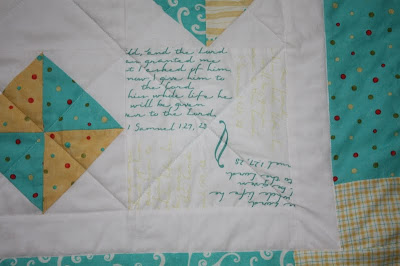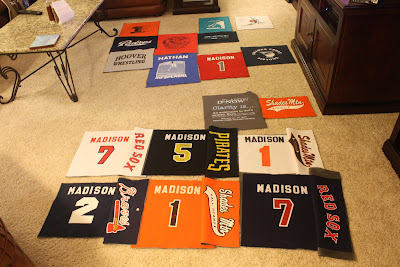Hi there! For all of you who want to learn how to make a t-shirt quilt, I'm going to tell you my secrets. As always, I don't claim to know all there is to know about making t-shirt quilts. I have made several, and I've learned plenty by doing it. Trial by fire, if you will. So, in order to keep you out of the proverbial fire, here's what I know.
Materials (Part 1 only!)
Pellon 911FF Featherweight Fusible Interfacing (any color)*
20-25 T-Shirts
Quilting Tools
Rotary Cutter
Cutting Mat & Ruler
6.5" Quilter's Square (optional)
Iron
Ironing Board
Press Cloth (optional)
*The amount of fusible interfacing you'll need will vary depending on the number/size of the shirts you're using. I think it's always good to start with 5 or 6 yards if you don't want to buy a bolt. I got a great deal on my bolt at Overstock.com. It's nice not having to worry about running out...
Step 1- Cut.
Use your rotary cutter, ruler and cutting mat to cut your t-shirts. Be very generous in cutting. You will trim and square up the shirts later. Don't throw scraps away just yet. You may need them later.
If I'm making the quilt for someone else, I ask them to designate which part(s) of each shirt they want me to use with painter's tape.
This shirt only has a design on the front, so I just cut through the whole shirt.
This shirt has designs on both sides, so I split the sides and opened the shirt before I cut my rectangles.
You should end up with a pile of rectangles like this...
For cutting pockets, I sometimes use a 6.5" quilter's square. It's easier for me if they're all the same size.
Step 2- Interface.
Lay out one t-shirt rectangle on your ironing board, right side down. Iron the back of your rectangle. Never iron the right side of a t-shirt. The design will melt!
Trim the interfacing to the proper size.
I don't usually trim all sides, but that's because I'm slightly lazy ;) I also don't mind if a little glue gets on my ironing board. It doesn't happen that often. I'm careful where I put the iron.
Fuse the interfacing in place according to the
manufacturer's instructions. Don't worry about trimming the interfacing down for seam allowances.
You should use a press cloth over your interfacing if you want to keep your iron nice and clean. I had a nasty accident with fusible fleece a while back, so being clean is not a possibility for my poor iron. I do use a spray bottle to keep everything nice and cool.
I cut 6.5" squares of interfacing for the pockets. The edges won't line up perfectly, but they come pretty close. Like I said earlier, you will do lots of trimming later.
So, that should keep you busy for a while. If you've finished this part, here's
Part 2!



























































